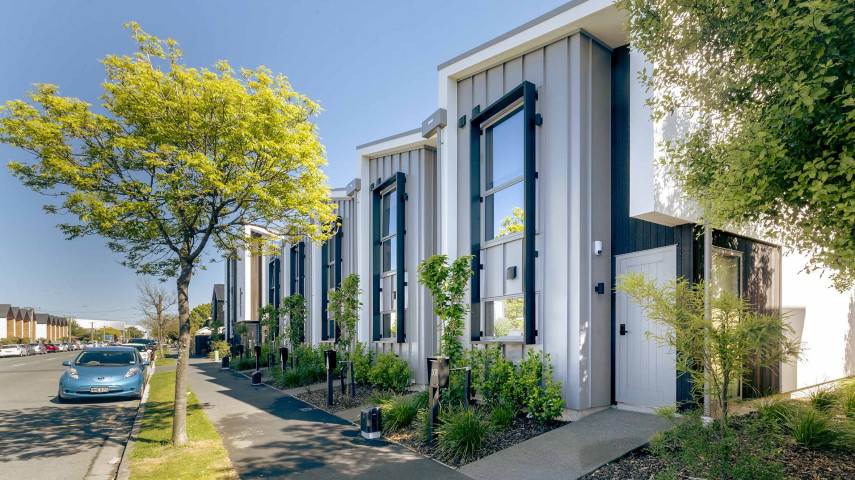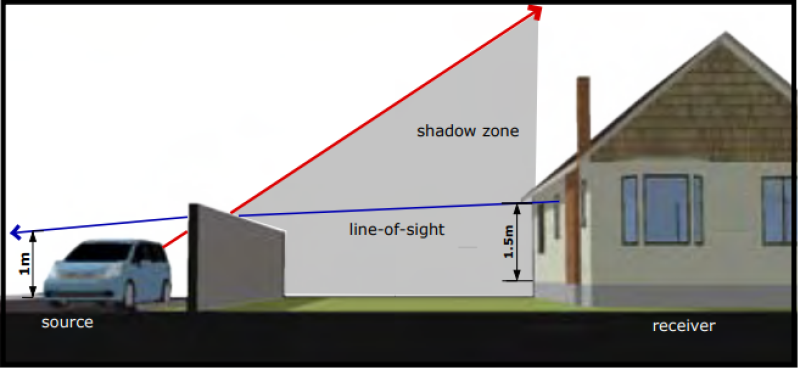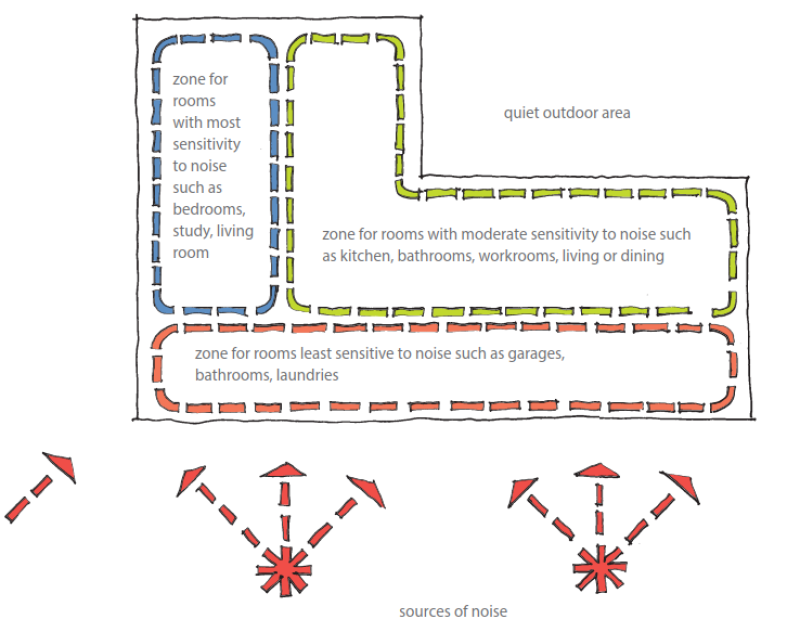The Central City offers prime opportunities for residential development, due to relaxed density limits, and available land. However, diverse activities contribute to higher noise levels in the Central City.

As the area attracts more residents, it is essential to prioritise homes that meet their needs. The Central City’s vibrancy is to be celebrated, but homes should also offer a quiet retreat for residents to unwind and get quality sleep, away from the hustle and bustle. Effective soundproofing of your development offers great returns and will be worth the investment you put in.
Wellbeing/satisfaction of residents
Robust sound insulation and design has a significant positive impact on the person living in your property, by enabling a calm, quiet environment, which is essential for a healthy, liveable home.
The WHO guidelines for community noise(external link) recommend less than 30 decibels in bedrooms during the night for good quality sleep. In a busy Central City, sound insulation is essential to achieve that kind of environment.
Prioritise soundproofing for your own or the future tenant's comfort and wellbeing.
Higher perceived value
In our growing Central City, an acoustically insulated home allowing people to live a healthy life in the middle of the action, will stand out among those that aren't. Discerning residents will place more value on a more liveable home, which can be good for an investor or developer.
Home rating systems like Homestar(external link) single out exemplary homes built above the minimum standard of the New Zealand Building Code. Building a Homestar home is a strong endorsement of your development's design and sustainability. The internal acoustic environment, and continuous mechanical ventilation, are considered in Homestar's rating scheme.
For a great example of sustainable, liveable homes in a noisier environment, check out the Ōtautahi Community Housing Trust’s social housing complex on Brougham Street.(external link)
Tenant satisfaction and longevity
A liveable home with quality sound insulation allows tenants quiet enjoyment of their property day and night. This may result in longer tenancies, higher levels of care for the dwelling, and a more favourable relationship with the property manager and developer. In your own home, sound insulation improves your own living experience.
Developer and landlord reputation
Related to tenant satisfaction, your reputation as a developer or property manager will benefit. As you become known for offering high-quality homes with robust sound insulation, your properties may be in higher demand among those who value a liveable Central City home.
In a louder environment like the Central City, good home construction and insulation can help to reduce impacts from noise. Consider the steps below when you're assessing or designing a potential home. We also recommend getting in touch with an acoustic expert, who can guide you through your specific situation. The Acoustical Society of New Zealand(external link)(external link) is a great place to start.
External noise
Think about the likely sources of noise that will be near your building and design it to reduce the noise's effects. If you're anticipating any bassy or unusually loud noise, get in touch with an acoustic expert.
External envelope – keeping noise out
To control noise intrusion (or noise breakout), the acoustical performance of the building envelope is the most important aspect of the building design.
Physical mass and insulated cavities are the key elements to improving the sound insulation performance of external walls. For example, a brick or concrete block external wall provides greater noise reduction than cedar weatherboards – about 50 decibels (dB) compared to 40. But lightweight claddings can have improved performance with increased internal plasterboard linings. For example, two layers of 13 mm-thick noise-rated plasterboard compared to a single 10 mm-thick plasterboard.
All external wall cavities need to be thermally insulated to meet Building Code thermal requirements. To get optimal acoustical performance too, fibrous insulation like glass wool, polyester, mineral wool and natural wool/polyester mixes, all offer very similar performance for equivalent thicknesses and densities. Rigid insulation like PIR offers excellent thermal properties but poor acoustic performance.
The weakest element in any building envelope will be the glazing and doors, and their performance is largely affected by having effective seals around all openable components. Most modern aluminium, PVC and European-style timber window frames have good quality seals and can work well acoustically. Most domestic thermal double-glazing will have a sound reduction effect of 30 to 35dB.
To significantly improve on this, secondary glazing – a second independent frame and glazing – will be needed. The second internal frame would need to be separated by at least 50mm from the external glazing, to have a meaningful acoustic impact.
Glazing can provide effective reduction of outside noise but not if windows need to be opened for ventilation. Balanced mechanical heat exchange ventilation systems therefore have an important role to play in noisy areas, as they allow windows to be kept closed while providing fresh air.
The Christchurch District Plan requires these systems for some situations(external link) (e.g. when building homes near a State Highway, railway, or arterial/distributor road) and they need to operate quietly so they don't become a noise problem for the homeowner. These and other noise-related rules for the Central City may be updated in an upcoming Plan Change.
Mechanical plant
Many homes have heat pumps to provide heating and cooling, and these have a unit that operates outside a dwelling, which can be an annoying noise source for the homeowner and their neighbours. Without due care, outdoor units can easily exceed the District Plan nighttime noise limits for residential areas, and it can be very difficult and expensive to move the units if they become an issue. The same goes for pool heat pumps, which are often placed close to property boundaries and may unduly affect neighbours./p>
Advice is to keep outdoor units as far as possible from bedroom windows. Try to eliminate the line of sight by using fences or outbuildings and specify that units must be installed on rubber vibration isolation mounts.
Along with the construction and insulation advice mentioned above, there are other aspects of your building's design.
Fencing
Fencing or other physical obstructions can block some noise and be particularly effective for reducing traffic noise. But for the fencing to work, it must also block the source of noise from view. Fences will be less effective for two-storey dwellings or where there are driveway openings in the fence.

The fence must also be solid and made from dense material, such as 19mm thick overlapping timber palings, and have minimal gaps.
District Plan rules relating to fencing height and permeability will need to be considered as well. For example, in Central City residential zones(external link), there is a one metre height limit for fences within two metres of the road boundary.
Specific fencing rules also apply to the Central City Business zone(external link), mixed-use zones(external link), and the South Frame zone(external link).
Bear in mind District Plan rules undergo changes, particularly with the Council's Plan Change 14 starting to take effect. The introduction of this Plan Change and other new zone rules may impact on fencing standards, so we advise you check rules before starting any work.
Layout
When building a home in a louder area, you want to increase the distance between the home and the noise. Ideally choose sites for development that are as far away from noise as possible. Within a site, the building should also ideally be placed as far as possible from any noise.
Position sensitive rooms like bedrooms, studies and living rooms further away from external noise, roads and late-night entertainment. Place less sensitive spaces like garages, bathrooms and laundries where receiver noise is highest.

Try not to locate windows or doors towards external noise or either minimise the size of any windows facing noise or provide appropriate multiple glazing (e.g. double or triple glazing).
Furnishing
Room furnishings, while not having the same effect as built-in noise control, can have a subtle, positive effect on sound.
- Thick curtains can absorb sound coming through windows – a common cause of sound leakage.
- Hard surfaces and floors lead to sound bouncing and reflecting in a room. Soft floors or surfaces like thick rugs can absorb and reduce sound.
- Upholstered chairs, sofas and bookcases can dampen noise. Place upholstered furniture near the sound source.
Controlling noise in this way is often a trade-off with other priorities: heating, sunlight, views, privacy and ventilation. Compromises may be necessary, depending on what you are willing to put up with.
Below are some example strategies to use, for various scenarios you might encounter when building in the Central City.
It's important to know that addressing noise issues can be complex, given the way sound can travel through the air and through structures. In many cases, seeking advice from an acoustic consultant will best quantify potential noise intrusion, identify the main points where noise could travel though a building, and offer the best sound mitigation advice.
This table shows potential mitigation strategies for a variety of scenarios:
| Scenario | Potential mitigation strategies | |
|---|---|---|
| 1 | Building design to limit intrusion of outside noise (traffic, port, industrial) |
|
| 2 | Hospitality venue design (limit noise spill of music to neighbours) |
As well as steps from scenario 1:
|
| 3 | Multi-unit residential design |
As well as steps from scenario 1:
|
| 4 |
Office space design |
Along with steps from scenarios 1 and 3:
|
| 5 |
Noise-sensitive spaces (music venues, music practice rooms/studios, schools, hospitals, etc.) |
Engage with an acoustic consultant |
| 6 | General noise mitigation principles |
|
Above are the essential principles to keep in mind when designing and building a home with adequate sound mitigation. More detailed information and expert guidance is available from various sources, including BRANZ,(external link) and NZTA(external link) (in the case of building near high-traffic roads).
Getting in touch with an acoustic expert can also help you find solutions for your specific situation.
